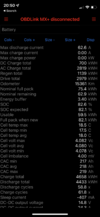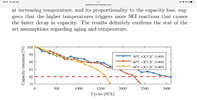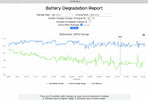While what you say
sounds plausible and your graphs certainly are pretty they clearly do not encompass all of reality. It's true there have been lots of cars reporting heavy degradation and all of the things you mention likely play some factor but it's also true there are also a number of people with cars that
don't fit your theory. As I've stated before my own first Model 3 was charged to 90% every night and I had no apparent degradation the first 1.5 years or so and only about 8% after 4 years 30k miles. It also gets warm here in California and every summer I would have had a large number of trips with road temps in the 40C-45C range. If I recall correctly I believe
@KenC 's experience also does not fit your theory that high degradation is 100% certain with the Model 3.
Since there are clear examples that show degradation is not as simple as you believe I don't think it's helpful to tell people so emphatically and with such certainty that charging to 80% is "the worst." The real-world data we have simply does not support that argument in many cases. Lots of people charge to 80% and are just fine. There are some people that have charged to even higher levels yet still have had reasonable degradation so to me that means we haven't found a good way to model expected range loss yet nor have we accounted for all the factors that contribute.
All research data tell us the same thing: Lithium batteries behave very predictable. Even if the cell capacity might differ slightly between batches, the behaviour is very predictable. You can review 10 or 15 sets of research reports of NCA battery tests, and you will see that the behaviour and degradation from time and cycles is more or less carbon copies. I actually have done that(read a lot of research), I started getting slightly interrested in the lithium battery world about 2006-2007.
For all research there is not really any exemptions that doesnt fit the very tight degradation curves. Within each research the variation between cells is extremely small and between research the variation is very small. The only thing that really differs is the conclusions. Some time you can see that the test data is following the same red line that all other research does, but the author did draw a conclusion that was wrong due to the fact that the test setup created holes in the findings. But if you take the data atn put it on top of another research report, you’ll see that the data is more or less carbon copies.
There is sometimes small deviations that is not important to us and that can be traced to different test setups. Despite this, we can see that the deviations is small.
This picture is from a research report of a 2170/21700 NCA cell of the type ”Manufacturer and cell model cannot be disclosed”.
One can suspect that it is a Panasonic NCA cell, as there isnt very many producers of NCA-chemistry. 256Wh/kg on the cell level.
This research report have a worse spoon form than most other NCA-tests, but in this case it actually is the 2170 cell, that we can guess is a Panasonic ncr21700. The reason for the spoon form is discussed in the report. Most other reports shows signs of the spoon form and that the worst SOC for calendar aging is around 75-80% but in most cases not this much. This report
might show us how the 2170 behave including the worst point at 80%. It might look worse than real life, in that case depending on the test setup but as we can see or scent the same behaviour in more or less any other research report there probably is something to it.
(
Link to the research report )
There is a common idea that Teslas advise ”above 90% only for trips” is due to the calendar aging killing the battery.
From all research reports we know that that is not really the case. There just isnt that much more calendar aging at SOC above 90%.
But we know from research that if you limit you most charging to 90%, the battery will hold up for the double amount of cycles. My (qualified) guess is that this fact is a important part of Teslas advice. Still, I wouldnt leave the car with 100% SOC. On the other hand, I wouldnt leave it with 80% either.
This research report test >250 NCA cells, of two different batches.
https://mediatum.ub.tum.de/doc/1355829/file.pdf#page35
A long read(186 pages), but really good. The very small differences in capacity within a batch, capacity loss independent of batch is clearly discussed. There is a lot of data, among them data that show that the calendar aging is about the same for 60 to 100% SOC, and there also is data like this: We only have three points but we clearly can see that 75% is worse than 45 and 100%, or at lest close to the 100% SOC.
This report also show the spoon form:
https://www.researchgate.net/profil...on-EV-Batteries.pdf?origin=publication_detail
It would be easy to show at least another 15 research reports that tell us the same, and if we go beyond NCA theres about 50 reports more, telling the same thing.
I think that it is not probable at all that all research show one thing, but when the same cells or closely related cells is put in a EV they start to behave different. So, the panasonic NCA cells in Tesla model 3 will follow this quite closely. If it was only one cell, we problablyt could see strange behavoiurs because of some minor defect in a few cases(despite researcxh finding the cells being very close). But for a complete pack, there shouldnt/couldnt be ”bad luck” for all 4416 cells. You could get a slightly less capacity to begin with, but the calendar and cyclic aging most probalbe follow the normal behaviour.
There might be differences in initial capacity due to different batches and maybe that one car has been standing with high SOC before delivery(I have seen show room cars with 97% that we can guess have been at 97% for extended time.)
Despite this the aging should be behaving the same, but the use differs. For me, the main suspect for unexpected differences is the BMS.
I still have a NFP of 80.5kWh, after 34K km and 14 months. Most M3P ’21 start around there. In real life my battery should have degraded by about 3% by now. It doesnt matter how I charge or ”calibrate” now, the NFP stays about 80.5kWh but this is most certain a BMS overestimate.
Theres a lot of Model 3 owners that are worried about the degradation and I think that it is a good idea to tell someone that charge daily to 80% and is worried about high degradation that 80% is about the worst SOC for calendar aging. Many of us can use a lower daily SOC, and many can use the ”charge just in time concep”.
The good thing is that for someone living in a colder climate, even 80% wont cause that much degradation as the temperature have a very high effect on the calendar aging, specially higher ambient temps. Still, even if 80% doesnt cause much degradation due to low ambient temps, it most probalby causes the highest calendar aging, end reducing the SOC will lessen the calendar aging.
I have 10pieces of Panasonic 2170 arriving soon for some long time tests etc, and I plan to do another order in a while, just to make sure they are from different batches. Time will tell.





